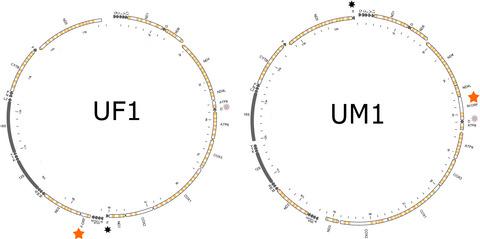当前位置:
X-MOL 学术
›
J. Zool. Syst. Evol. Res.
›
论文详情
Our official English website, www.x-mol.net, welcomes your
feedback! (Note: you will need to create a separate account there.)
Doubly uniparental inheritance of mitochondrial DNA in freshwater mussels: History and status of the European species
Journal of Zoological Systematics and Evolutionary Research ( IF 2.0 ) Pub Date : 2020-05-13 , DOI: 10.1111/jzs.12381 Marianna Soroka 1
Journal of Zoological Systematics and Evolutionary Research ( IF 2.0 ) Pub Date : 2020-05-13 , DOI: 10.1111/jzs.12381 Marianna Soroka 1
Affiliation

|
Doubly uniparental inheritance (DUI) is a mode of inheriting mitochondrial DNA that is distinct from strictly maternal inheritance. It has been described in nine and three families of marine and freshwater mussels, respectively, including the European margaritiferids and unionids. Among the 16 freshwater species of Unionida inhabiting Europe, DUI has been described in 9 species of dioecious mussels and was absent from a single hermaphroditic species and from secondary hermaphroditic specimens. The DUI freshwater mussels include two vastly genetically different mitochondrial genomes: maternal (F genome) and paternal (M genome), which coexist within the same specimen but in different tissues. The F genome is present in all female tissues and somatic male tissues. It is inherited in the typical, maternal, manner. Conversely, the M genome is located primarily in the male gonads and generative cells, and is inherited paternally. Dioecious Unionidae display unique characteristics that have been interrelated for over 200 million years: a high fidelity of the transmission of the F and M genomes in DUI and two paths of spermatogenesis–the typical path that produces sperm cells containing mitochondria with the F genome and the atypical path that produces sperm cells with the M genome. The mitogenomes of freshwater mussels display unique features that are not present in any other animal, that is, an additional, gender‐specific gene and an elongated cox2 gene occurring exclusively in the M genome. These features mean that the mitochondria, in addition to their basic function of producing energy, also may take part in determining sex in these dioecious organisms.
中文翻译:

淡水贻贝中线粒体DNA的双重单亲遗传:欧洲物种的历史和地位
双重单亲继承(DUI)是一种继承线粒体DNA的方式,不同于严格的母体继承。分别在9个和3个海洋和淡水贻贝科中进行了描述,包括欧洲的margaritiferids和unionids。在居住于欧洲的Unionida的16种淡水物种中,DUI已在9种雌雄异体的贻贝中进行了描述,单个雌雄同体物种和次生雌雄同体标本中都没有DUI。DUI淡水贻贝包括两个遗传上完全不同的线粒体基因组:母体(F基因组)和父系(M基因组),它们共存于同一标本中,但存在于不同组织中。F基因组存在于所有女性组织和体细胞男性组织中。它以典型的母体方式继承。反过来,M基因组主要位于雄性腺和生殖细胞中,并且是父系遗传的。雌雄异体的双翅目显示了已经联系了2亿多年的独特特征:DUI中F和M基因组的高度保真传播以及精子发生的两种途径-典型的途径是产生含有线粒体和F基因组的精子细胞。产生具有M基因组的精子细胞的非典型途径。淡水贻贝的有丝分裂基因组显示出其他任何动物都没有的独特特征,即另外一个性别特定的基因和一个细长的基因 F和M基因组在DUI中的传递具有很高的保真度,并且具有两种生精途径-产生包含F基因组线粒体的精子细胞的典型途径,以及产生包含M基因组的精子细胞的非典型途径。淡水贻贝的有丝分裂基因组显示出其他任何动物都没有的独特特征,即另外一个性别特定的基因和一个细长的基因 F和M基因组在DUI中的传递具有很高的保真度,并且具有两种生精途径-产生包含F基因组线粒体的精子细胞的典型途径和产生包含M基因组的精子细胞的非典型途径。淡水贻贝的有丝分裂基因组显示出其他任何动物都没有的独特特征,即另外一个性别特定的基因和一个细长的基因cox2基因仅存在于M基因组中。这些特征意味着线粒体除了具有产生能量的基本功能外,还可以参与确定这些雌雄异体的生物的性别。
更新日期:2020-05-13
中文翻译:

淡水贻贝中线粒体DNA的双重单亲遗传:欧洲物种的历史和地位
双重单亲继承(DUI)是一种继承线粒体DNA的方式,不同于严格的母体继承。分别在9个和3个海洋和淡水贻贝科中进行了描述,包括欧洲的margaritiferids和unionids。在居住于欧洲的Unionida的16种淡水物种中,DUI已在9种雌雄异体的贻贝中进行了描述,单个雌雄同体物种和次生雌雄同体标本中都没有DUI。DUI淡水贻贝包括两个遗传上完全不同的线粒体基因组:母体(F基因组)和父系(M基因组),它们共存于同一标本中,但存在于不同组织中。F基因组存在于所有女性组织和体细胞男性组织中。它以典型的母体方式继承。反过来,M基因组主要位于雄性腺和生殖细胞中,并且是父系遗传的。雌雄异体的双翅目显示了已经联系了2亿多年的独特特征:DUI中F和M基因组的高度保真传播以及精子发生的两种途径-典型的途径是产生含有线粒体和F基因组的精子细胞。产生具有M基因组的精子细胞的非典型途径。淡水贻贝的有丝分裂基因组显示出其他任何动物都没有的独特特征,即另外一个性别特定的基因和一个细长的基因 F和M基因组在DUI中的传递具有很高的保真度,并且具有两种生精途径-产生包含F基因组线粒体的精子细胞的典型途径,以及产生包含M基因组的精子细胞的非典型途径。淡水贻贝的有丝分裂基因组显示出其他任何动物都没有的独特特征,即另外一个性别特定的基因和一个细长的基因 F和M基因组在DUI中的传递具有很高的保真度,并且具有两种生精途径-产生包含F基因组线粒体的精子细胞的典型途径和产生包含M基因组的精子细胞的非典型途径。淡水贻贝的有丝分裂基因组显示出其他任何动物都没有的独特特征,即另外一个性别特定的基因和一个细长的基因cox2基因仅存在于M基因组中。这些特征意味着线粒体除了具有产生能量的基本功能外,还可以参与确定这些雌雄异体的生物的性别。











































 京公网安备 11010802027423号
京公网安备 11010802027423号